Candling Eggs is an easy process that gives you assurance that your eggs are fertile and developing correctly after a short period of time in the incubator. It allows you to remove infertile eggs and soon you will start to be able to identify ‘bad eggs’ and remove these as well. The candling photos on this page should help you to identify these.
Although it has never happened to me, bad eggs can sometimes explode or ooze in the incubator causing bacteria to contaminate the other good eggs, causing them, in turn to go bad.
I usually candle my eggs after a week of incubation. It can of course be done before this but the first week of incubation is the most critical in terms of getting the correct development of the embryo so leaving the eggs alone during this time is good practice. After a week, we are a third of the way through incubation and it is far easier to identify fertile eggs, even if eggs have a dark shell as is the case with Marans.
How to candle eggs
You will need a bright light and a way of shining this through the egg. Candlers can be bought online from poultry shops, or you can make one using a bright light and a cardboard box with a hole cut out for the egg to sit on. Try to get the best seal around the hole and candle in a dark room to see the best results.
Candling Dark Eggs
If the shells are dark or have pigments / marks on them, it can be difficult seeing the embryo. I rock the egg from side to side very gently so the contents move. This must be gentle, or you risk damaging the Chalazae that hold the yolk / developing embryo.
“The Chalazae is the structure that suspends the yolk within the egg. It can be damaged by shocks and vibration”
Remember not to candle for too long if it is heating the egg. I spend around 8 seconds per egg before trying the next one.
What to look for after a week
After 7 days, you should be able to see development of the embryo, including spider like veins and even (if you are lucky) a little movement. The embryo often sits on one side of the egg so be sure to rotate the egg around slowly to get the best view. Occasionally, you may see a tiny heart beating if it is close to the edge of the shell.
Look for fertile and non fertile eggs. Clears as they are called are easy to remove after 7 days. If you have a number of eggs in the incubator, it soon becomes clear which eggs have developed correctly.
By day 7, you should clearly see the embryo. Don’t forget to turn the lights out in the room when you do this so you get a clearer picture!
What to look for after two weeks
After 14 days, the embryo is well developed and turning into a chick. Two thirds of the egg is now covered and it is hard to see any detail.
Look for embryos that have developed so far but died. This can be for a number of reasons, including incubation technique, damage to the chalazae (which can happen when eggs are dropped / damaged in the postal system for example) or become infected with bacteria. A red ring is sometimes seen inside the egg which is the bacterial infection.
The photo to the right shows how much of the egg is now filled with the embryo / soon to be chick. It is more common to see movement inside the shell.
Bad Eggs
If an egg appears bad, it can be removed to prevent it from exploding and contaminating other eggs. Bad eggs can look different every time but if you compare them to the bulk of the other good eggs in the incubator, it won’t be long before you can recognise a bad egg from the rest. The bad egg shown to the right was found at day 14, two weeks into incubation. Clearly comparing this to our last photo, there is a problem.
Bad eggs don’t change – so if you are unsure, mark it and have another look a few days later to see if it still looks the same.
The second photo shows to the right shows the contents of this bad egg after it was opened on a plate. I wouldn’t normally do this because it can be smelly but was worth while to show what the contents looked like, clearly not a nearly developed chick!
There are a few more photos on poultrykeeper’s candling chicken eggs page here.

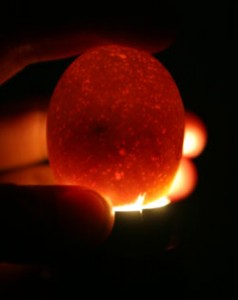
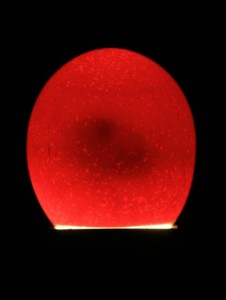
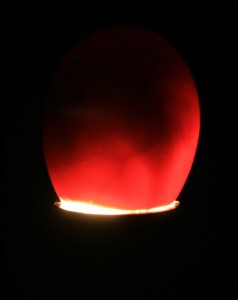
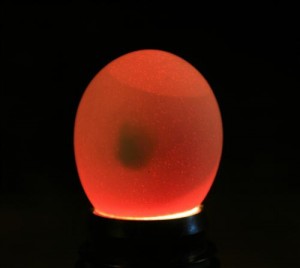
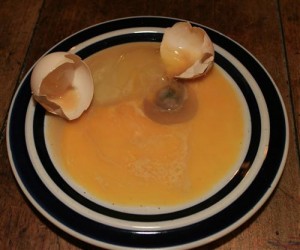



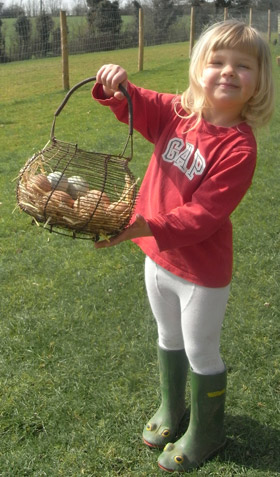

Hi, I candled my eggs at 7 days into incubation and all 6 had movement in them. I have just candled again at 11 days and can only see movement in 4 of them. Could the 2 chicks be asleep in the egg when I candled them? As they look the same as the other 4! Or should there be movement all the time when you candle? Thanks I hope that all made sense?
There isn’t always movement when candling.
Thanks for your previous advice… We are now at day 14 and I just kept three of the eggs. Two of them look fine and I can still see veins and movement. The third looks about the same size as the others but I can see no veins nor movement… Should I discard it? By the way… I hate my avatar… but have no time to make one now… just picture me … sane. Thanks
If in doubt, I would keep eggs in longer. You can see the lack of developement by comparing to other eggs later on and then remove.
Sorry about the Avatar. It’s not good is it 🙁 They are automatically generated if you don’t have one set with Gravatar and I can’t change them individually.
I have a blue chicken egg, and it has a large crack on it. I put candle wax on it and it is only day 2 for now. Will it live? I candled it today and I saw these little white spots on it. Right now it is under a *99 lamp. Like I said before will it live? I have always wanted to hatch a chick.
Hmm I wouldn’t hatch just one… chickens are flock animals, it’s not fair. As for the viability of the egg, it’s hard to say. It depends on the crack and whether bacteria gets in and infects the egg.
i have a 12 day egg incubating that got slightly cracked at the tope of the egg ( the large end) on around day 5. when candled at day 6 and 12 there is development and movement. is there anything i need to do?
Hmm tough one… You can try nail varnish to seal it but if there is bacteria inside the egg, it will go bad.
I have two chicken eggs in an incubator. They are due to hatch tomorrow. I candled them last night. Is it normal to see just the air bubble? The top half of the egg was dark and nothing was visible. I think my flash light could have had something to do with that? It’s my first go at this and just wanted to make sure that was normal.
During the later stages, the chick almost fills the shell – so you have a dark patch and only the air sac is visible at the broad end of the egg.
Hi. I have 9 quail eggs and I’m very scared I might have killed almost all of them. It’s day 7 and I have already candled them a few times during this past week. I didn’t know candling at this early time could harm them since the website I read before said it was okay as long as they stayed warm. But I looked at them today and the embryos who had heartbeats two days ago now look brownish and don’t move. Only 4 of the eggs seem to be fertile and there is only one that has clearly grown larger than the others. It is looking darker in there now. I thought it looked a bit brown but It must be okay since there is lots of movement and long spider veins. I have to transfer the eggs to my dad’s house tonight and I was wondering how I could reduce risks to my last egg.. I’m not going to candle again until next week because I fear that might have been what killed the others. Should I remove the eggs I think are dead or wait a few more days?
If you don’t over heat the eggs, they should be ok. Bad eggs should be removed.